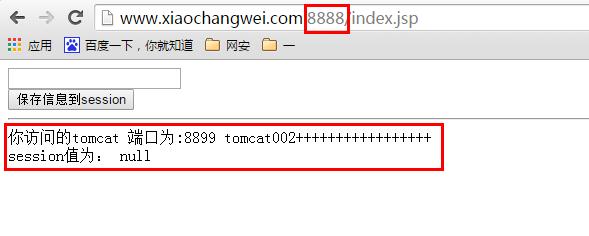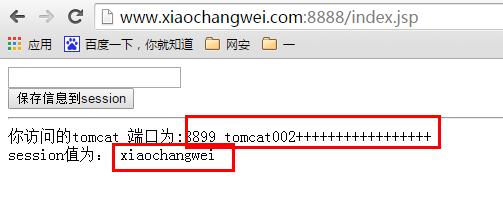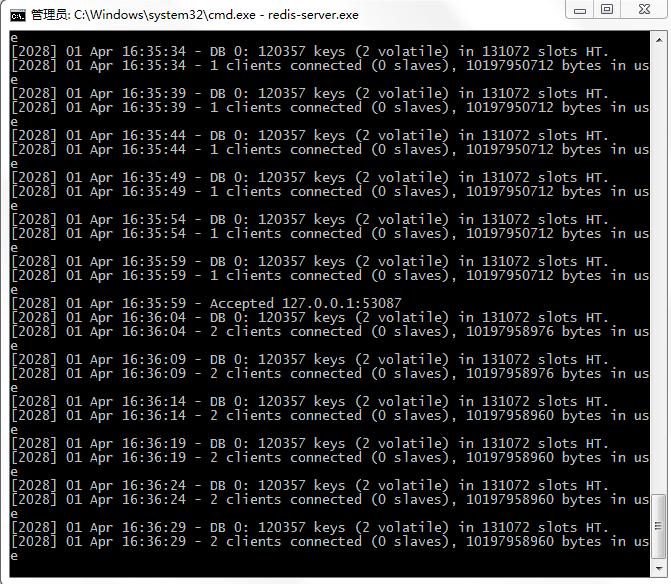nginx作为负载均衡根据定义将不同的用户请求分发到不同的服务器,同时也解决了因单点部署服务器故障导致的整个应用不能访问的问题
在加入nginx之后,如果多个服务器中的一个或多个(不是全部)发生故障,均不影响用户的正常使用,会将用户请求分发到可以提供服务的服务器上
本节实例仅实现 一个nginx + 2个tomcat + redis实现java web应用的自由切换,并保持用户会话信息,对前端用户完全不可见。
会话的共享是为了保证用户在首次登录系统后已经后续的会话不会因为nginx重新分发到其他服务器而再次登录,达到会话信息共享
本例在windows下采用的是
nginx 1.9.13
tomcat 7.0.64
redis 2.8
操作步骤:
① 准备两个tomcat,并修改端口,修改tomcat/webapps/ROOT中index.jsp内容为:
<%@ page language="java" contentType="text/html; charset=UTF-8" pageEncoding="UTF-8"%> <% String username = request.getParameter("username"); System.out.println("username:"+username); if(username!=null){ session.setAttribute("userSession", username); System.out.println("value in session is :" + session.getAttribute("userSession")); } %> <!DOCTYPE html PUBLIC "-//W3C//DTD HTML 4.01 Transitional//EN" "http://www.w3.org/TR/html4/loose.dtd"> <html> <head> <meta http-equiv="Content-Type" content="text/html; charset=UTF-8"> <title>ngix+tomcat+redis session共享验证</title> </head> <body> <form action="index.jsp"> <input type="text" name="username" value=""/> <br/> <input type="submit" value="保存信息到session"/> </form> <hr/> <!-- 不同tomcat请使用不同mark 以便识别 --> 你访问的tomcat 端口为:8898 tomcat001 <br/> session值为: <%=session.getAttribute("userSession") %> </body> </html>
并保证两个tomcat都能正常启动,并能正常访问
② 下载ngix并修改conf文件如下

#Nginx所用用户和组
#user niumd niumd;
#工作的子进程数量(通常等于CPU数量或者2倍于CPU)
worker_processes 1;
#错误日志存放路径
#error_log logs/error.log;
#error_log logs/error.log notice;
error_log logs/error.log info;
#指定pid存放文件
pid logs/nginx.pid;
events {
#使用网络IO模型linux建议epoll,FreeBSD建议采用kqueue
#use epoll;
#允许最大连接数
worker_connections 1024;
}
http {
include mime.types;
default_type application/octet-stream;
#定义日志格式
#log_format main '$remote_addr - $remote_user [$time_local] $request '
# '"$status" $body_bytes_sent "$http_referer" '
# '"$http_user_agent" "$http_x_forwarded_for"';
#access_log off;
access_log logs/access.log;
client_header_timeout 3m;
client_body_timeout 3m;
send_timeout 3m;
client_header_buffer_size 1k;
large_client_header_buffers 4 4k;
sendfile on;
tcp_nopush on;
tcp_nodelay on;
#keepalive_timeout 75 20;
include gzip.conf;
upstream localhost {
#ip_hash
#ip_hash; #测试时请不要打开ip_hash 否则不会在不同server间跳转,第一次访问的哪一个就会一直访问哪一个server
#下面为配置的server列表,weight表示权重,值越大分配到的请求就越多,默认为1.
server localhost:8898 weight=1;
server localhost:8899 weight=1;
}
server {
listen 8888; #8888为监听的端口,所以访问时就要通过 ip:8888来访问
server_name localhost;
location / {
proxy_connect_timeout 3;
proxy_send_timeout 30;
proxy_read_timeout 30;
proxy_pass http://localhost; #这里的名字要和上面upstream后面跟的名字一致
}
}
}
2016-06-06增加静态资源缓存设置和获取真实客户端

#Nginx所用用户和组
#user niumd niumd;
#工作的子进程数量(通常等于CPU数量或者2倍于CPU)
worker_processes 1;
#错误日志存放路径
#error_log logs/error.log;
#error_log logs/error.log notice;
error_log logs/error.log info;
#指定pid存放文件
pid logs/nginx.pid;
events {
#使用网络IO模型linux建议epoll,FreeBSD建议采用kqueue
#use epoll;
#允许最大连接数
worker_connections 1024;
}
http {
include mime.types;
default_type application/octet-stream;
#定义日志格式
#log_format main '$remote_addr - $remote_user [$time_local] $request '
# '"$status" $body_bytes_sent "$http_referer" '
# '"$http_user_agent" "$http_x_forwarded_for"';
#access_log off;
access_log logs/access.log;
client_header_timeout 3m;
client_body_timeout 3m;
send_timeout 3m;
client_header_buffer_size 1k;
large_client_header_buffers 4 4k;
sendfile on;
tcp_nopush on;
tcp_nodelay on;
#keepalive_timeout 75 20;
include gzip.conf;
upstream localhost {
#ip_hash
#ip_hash; #测试时请不要打开ip_hash 否则不会在不同server间跳转,第一次访问的哪一个就会一直访问哪一个server
#下面为配置的server列表,weight表示权重,值越大分配到的请求就越多,默认为1.
server localhost:8898 weight=1;
server localhost:8899 weight=1;
}
server {
listen 8888; #8888为监听的端口,所以访问时就要通过 ip:8888来访问
server_name localhost;
#charset koi8-r;
#access_log logs/host.access.log main;
location / {
proxy_connect_timeout 3;
proxy_send_timeout 30;
proxy_read_timeout 30;
proxy_pass http://localhost; #这里的名字要和上面upstream后面跟的名字一致
root html;
index index.aspx index.html index.htm;
#设置主机头和客户端真实地址,以便服务器获取客户端真实IP
proxy_set_header Host $host;
proxy_set_header X-Real-IP $remote_addr;
proxy_set_header X-Forwarded-For $proxy_add_x_forwarded_for;
}
#静态资源缓存设置
location ~ .(jpg|png|jpeg|bmp|gif|swf|css)$
{
expires 30d;
root /nginx-1.9.3/html;#root:
break;
}
#error_page 404 /404.html;
# redirect server error pages to the static page /50x.html
#
error_page 500 502 503 504 /50x.html;
location = /50x.html {
root html;
}
}
}
③ cmd窗口中启动nginx 停止用nginx -s stop命令
④下载redis并在cmd中执行server.exe启动,可根据需要修改redis.conf中的端口 port 6379 ,默认端口为6379 停止使用 redis-cli shutdown
⑤ 新建maven工程并选择和本地java_home版本一致的jdk,将https://github.com/jcoleman/tomcat-redis-session-manager 代码加入依赖并打包(打好的jar包在文章末尾有下载地址)
⑥ 修改tomcat/conf下context.xml为

<?xml version='1.0' encoding='utf-8'?> <!-- Licensed to the Apache Software Foundation (ASF) under one or more contributor license agreements. See the NOTICE file distributed with this work for additional information regarding copyright ownership. The ASF licenses this file to You under the Apache License, Version 2.0 (the "License"); you may not use this file except in compliance with the License. You may obtain a copy of the License at http://www.apache.org/licenses/LICENSE-2.0 Unless required by applicable law or agreed to in writing, software distributed under the License is distributed on an "AS IS" BASIS, WITHOUT WARRANTIES OR CONDITIONS OF ANY KIND, either express or implied. See the License for the specific language governing permissions and limitations under the License. --> <!-- The contents of this file will be loaded for each web application --> <Context> <!-- Default set of monitored resources --> <WatchedResource>WEB-INF/web.xml</WatchedResource> <!-- Uncomment this to disable session persistence across Tomcat restarts --> <!-- <Manager pathname="" /> --> <!-- Uncomment this to enable Comet connection tacking (provides events on session expiration as well as webapp lifecycle) --> <!-- <Valve className="org.apache.catalina.valves.CometConnectionManagerValve" /> --> <Valve className="com.orangefunction.tomcat.redissessions.RedisSessionHandlerValve" /> <Manager className="com.orangefunction.tomcat.redissessions.RedisSessionManager" host="localhost" port="6379" database="0" maxInactiveInterval="60" /> </Context>
⑦修改tomcat/conf/server.xml中engine信息 增加jvmRoute 标示
<Engine name="Catalina" defaultHost="localhost" jvmRoute="jvm8899">
⑧ 拷贝第⑤步打好的jar包以及依赖的jedis-2.7.2.jar commons-pool2-2.4.1.jar到每个tomcat的lib目录下
⑨ 先启动redis,再启动所有tomcat,最后启动nginx 输入nginx监听的端口进行访问,结果如下:
最开始没有输入session信息时,多次刷新将显示访问到了两个不同的tomcat


在输入框中输入信息并保存,再不断刷新


在执行过程中,也会看见redis控制台不停的有相应信息输出

后期我会将所有的实例代码及配置文件全部放到我的网盘,欢迎下载验证,相互交流
下载地址: http://pan.baidu.com/s/1pK7GIbp
下一篇文章我将以具体demo方式展示在linux环境下,采用keepalived+mysql主主双活, 在某个mysql遇见故障不能提供服务时进行mysql自动切换
mysql主从同步请参考我之前的文章:http://www.cnblogs.com/xiaochangwei/p/4824355.html
